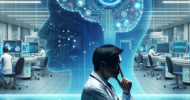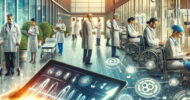by Alison McKnight
We are surrounded by technology. No matter where you go, you will find technology rearing its face, whether ugly and ungodly or tempting and beautiful. These advances have brought both good and evil to many professions, especially healthcare.
Twenty years ago, you would not have found signs instructing people to turn off their cell phones in physician offices. Now these signs litter both the reception area and exam rooms. How does this technology add and detract from the care that the patient receives?
While most people do not use their cell phone during a visit with their physician, I am sure that there is still the text-aholic teen who can’t lay the phone down for enough time to get through the appointment with their physician. While using technology, such as the cell phone, may be rude if it is used at inappropriate times, it is not all evil.
Technology has brought immense benefit to both the physician and patient alike. When one has symptoms, they can simply type them into Google and pull up a plethora of pages on their condition. One can pull up discussions from people who have had the condition and have undergone certain treatments for it in addition the classic WebMD page that lists off what conditions you can have based on the symptom(s) you typed. Not only that, but prescribed drugs can be researched by both physicians and patients alike using technology. Physicians can avoid prescribing drugs that may interact with each other by using a computer program which all of the patient’s current medications that they are taking are input, and any interactions pop up on the screen. Best of all, it can be accessed 24/7 from just about anywhere on a device that can connect to the internet (except in the case of computer software, which needs to be installed). However, this free access to information can become a hindrance to care.
Diseases are complex, and the various functions of the parts of the human body can be even more complex. Sometimes there is just too much information to sift through, too many pages on the internet that contain information on the disease in question and the biological processes of the body parts involved. Some of this information may be good while others may be bad and misguided, and filtering through what is good and bad information can be taxing and time-consuming. On top of it, there is a lot of medical jargon that is used that may confuse the patient, or that the patient may skip over. Sometimes these words serve as useless clutter, but many other times, it plays a very important role in understanding the disease. By skipping over these words, patients may end up with only half of an understanding of the diagnosis, but they may think that they fully understand it. That is where the relationship with the physician comes in. While it is only common sense that if someone doesn’t understand a word they should look it up, the same cannot be said for difficult processes. Patients who desire an understanding of their diagnosis should research their condition on their own and come to the doctor to see how this relates to their case. Danger exists when the patient thinks they A) know it all or B) have every worst case scenario relate to their case. It may be up to the physician to help correct this wrong thinking, but it is up to the patient to acknowledge and change it (this can be especially hard for patients and care should be taken and the patient given a fair amount of support from the physicians and others who are close to them). A bit of humility on the patient’s end and some patience on the physician’s end may do wonder in correcting this.
Medicine especially has benefited from the advance in technology. Where surgery was once open, messy, and produced extensive visible scars, it now is very cosmetic, quick, and clean. It is amazing what technology has done for people, as technology has given people the ability to walk, when only decades before, the same person would have been relegated to sit in a wheelchair for the rest of his/her life. Technology has also reduced the number of fatalities during surgery, as there are ways to stop bleeding before it gets too out of hand and to stabilize people in a quick amount of time. However, despite all the positive things that technology brings, it can also bring not-so-great things to medicine as well.
It was said in my persuasion class in my sophomore year of college that we are met with clutter, and that we must sort through this clutter on a daily basis. Technology brings with it its own clutter that must be sorted through, and sorting through it can become incredibly exhausting and time-consuming for the physician. Despite the fact that technology may streamline healthcare and make prescribing medicine easier, it can be a headache at times. No matter how hard someone secures records, the database can still be hacked into. That being said, it is not just computer files that are being accessed, it is people’s private information that may be leaked and sold. One also must think about the problems that computers have. They freeze and crash, and this may not be effective when it comes to a physician having to prescribe something in a timely manner. Not only that, but if someone who is unauthorized to prescribe gets hold of the physician’s information for e-prescribing, medication may be dispensed without the physician knowing, a sort of “physician identity theft.” Without any other safeguards in place, “physician identity theft” would become another reality and burden that is heaped up on already overburdened physicians. Keeping this in mind, technology is probably best left to researching diseases, and the good pen and pad are still the best way to prescribing medication, as this takes the physician’s knowledge and signature to fill the prescription.
Medicine has been greatly impacted by technology, but technology has its place in medicine. While technology is good in researching conditions and drug interactions, it has no place in prescribing medication without other safeguards in place, as there still needs to be an actual physical authorization from the physician. While technology can improve communication with a physician (someone who is too busy to set an appointment with their doctor can easily e-mail or call them if they have any concerns) and the quality of care that a patient receives, it does not replace the physical presence of a patient in an office and the relationship that the physician and patient have, nor should it be allowed to replace this visit in the future.
Alison McKnight is a nursing student.
Submit a guest post and be heard on social media’s leading physician voice.












![Working patients and health care [PODCAST]](https://www.kevinmd.com/wp-content/uploads/Working-patients-and-health-care-190x100.jpg)



![AI’s role in simplifying communication [PODCAST]](https://www.kevinmd.com/wp-content/uploads/AIs-role-in-simplifying-communication-190x100.jpg)

